Electric Vehicle Market by Component, Vehicle Type, Vehicle Class, Propulsion (BEV, PHEV, FCEV), Vehicle Drive Type (FWD, RWD, AWD), E/E Architecture, Top Speed, Charging Point Type, Vehicle Connectivity, End Use, & Region - Global Forecast 2030
[440 Pages Report] The global electric vehicle (EV) market is projected to grow from USD 396.4 billion in 2024 to USD 620.3 billion by 2030 at a CAGR of 7.7%. Many factors are collectively driving the market. The most important of these is the reduction of the total cost of ownership through lower fuel and maintenance costs than traditional internal combustion engine (ICE) vehicles. The energy density has significantly improved while the cost has substantially decreased, thereby enabling electric vehicles to have larger driving ranges and yet be cheaper at the same time. Architectural breakthroughs came with innovations like the 800V E/E systems and better vehicle performance by cutting back charging time. The development of charging infrastructure associated with high-power fast chargers will make electric vehicles convenient for long travel. All of the advancements in technology and infrastructure are boosting the penetration of electric vehicles globally.
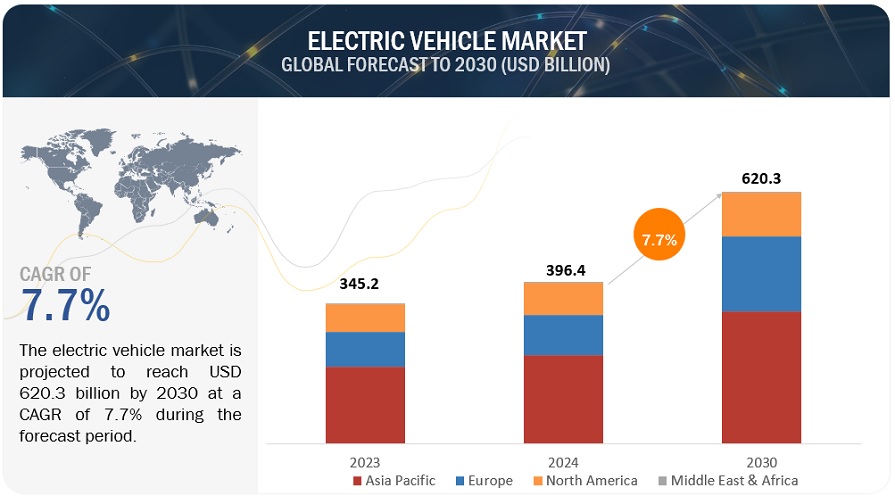
To know about the assumptions considered for the study, Request for Free Sample Report
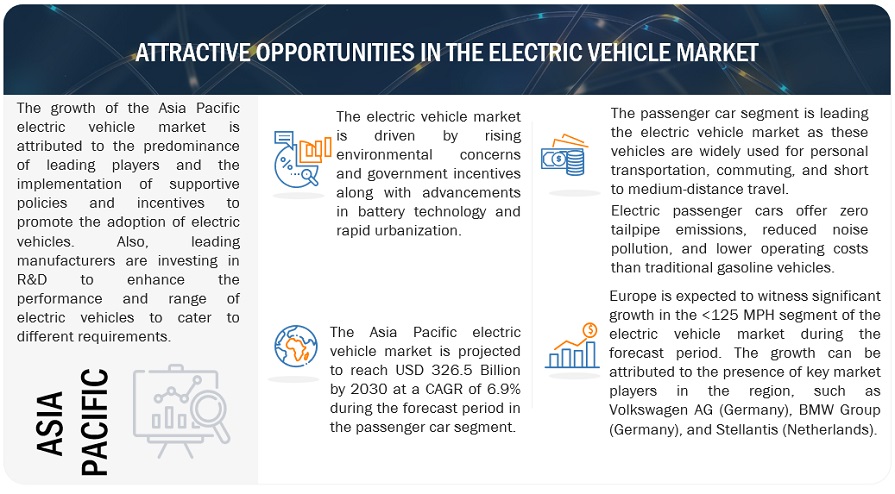
To know about the assumptions considered for the study, download the pdf brochure
Market Dynamics:
Driver: Advancement in Battery Technology
Recent developments in battery technology are altering the landscape of the electric vehicle industry when it comes to range, efficiency, and price. The most common battery type for electric vehicles today is lithium-ion, and it has seen significant improvements in recent years. R&D is ongoing on increasing the energy density of lithium-ion batteries so that they can store more power without making them larger or heavier than necessary. Instead, this has led to the development of longer-range electric cars, thus addressing one major concern most people had with regard to buying an electric car. Beyond lithium-ion batteries, technologies focused on transforming the electric vehicle industry are also being developed. For instance, the latest studies have introduced solid-state batteries that utilize solid electrolytes instead of liquids, which results in highly improved safety parameters and enhanced energy densities. Hence, these types of batteries are not likely to experience overheating cases compared to other conventional types, thus ensuring their prolonged lifespan while enabling faster charge times. With companies such as QuantumScape and Toyota's hard work, the development of solid-state batteries is expected to witness significant adoption in a few years. Toyota is committed to having such technology ready for commercial use by 2027-2028, with a solid-state battery that can travel 1,000 km and a charging time of 10 minutes is expected.
Restraint: Battery Longevity and Replacement Costs
Electric mobility is one of the best ways to reduce greenhouse emissions and replace diesel electric locomotives. Battery lifetime and the cost of buying a new battery pose problems. Also, the low driving range owing to battery degradation turns out to be a genuine problem for most people wanting to drive an electric car. Although more efficient battery technology offers better hope to users, the spectrum of 'range anxiety' is still problematic in the minds of those who, instead of taking short trips, require cross-country trips or lack the luxury of charging at a suitable spot. In addition, the usefulness of the battery is affected by the following factors: user practices, charging habits, and environmental conditions.
Even though electric vehicle batteries may have an estimated cost of up to tens of thousands of dollars, buyers need to readjust their selection preference according to car type and battery size. This expense can scare away many first-time buyers and generate concerns about the long-term affordability of electric cars versus gas ones.
Opportunity: Rapid Investment in Charging Infrastructure
Ever since governments and private entities began installing fast charging stations, battery ownership has become easier and more convenient for people. Modular platforms enable OEMs to cut down on the time it takes from product launch to production, which simplifies the introduction of different electric vehicle types at lower prices. With different models available, these platforms provide a flexible and scalable solution that can meet changing customer preferences over time. Moreover, vehicle efficiency and performance are improved through developments in Electric/Electronic (E/E) architecture, such as the integration of 800V systems into vehicles. The ultimate aim is to ensure a reliable supply of critical components within battery pack/cell manufacturing by climbing up the value chain into the Apple core among OEMs. Hence, vertical integration provides cost benefits but allows for improved control over battery technology's quality and innovation.
Challenge: Lack of Standardization of Electric Vehicle Charging Infrastructure
Electric vehicle charging stations might not work with all types of voltages. AC charging stations deliver a voltage of 120V AC through Level 1 charging stations and 208/240V AC through Level 2 charging stations, while DC charging stations provide fast charging with 480V AC.
Governments should standardize charging infrastructure to develop an enabling environment and boost electric vehicle sales. Fast charging is not standardized in different countries. Japan uses CHAdeMO; Europe, the US, and Korea use CCS; and China uses GB/T. The Indian government directed the installation of both CHAdeMO and CCS as the country lacks standardization with respect to fast charging. However, it increased the cost of installation of charging stations. In July 2019, the Indian government changed the guidelines by which developers can select any one method they want to adopt for their fast-charging stations. The US-based electric car manufacturer Tesla has high-performance superchargers available for Tesla cars only; these superchargers cannot be used for other electric vehicles; this is now slowly being addressed.
Market Ecosystem

High Demand For Home Charging To Drive Market.
DC supercharger sales are expected to be the highest in the Asia Pacific region during the forecast period. This ramp-up is fueled by a growing number of medium and heavy-duty electric vehicles, including commercial trucks, vans, as well as transit buses, which make use of DC fast chargers, while companies such as Uber and Lyft have established fast charging hubs. Toyota's North America division announced in July 2024 that they will be investing in the Lonna network for DC fast chargers, which will have BMW, General Motors, Honda, Hyundai, Kia, Mercedes Benz, and Stellantis as founding partners. The first charging stations will come up late in 2024, but the target is to have 30,000 ports, including both Tesla's NACS and CCS ports, by 2030 throughout North America. Supercharging facilities are widely available in China; in Japan and South Korea, their networks are expanding rapidly. Every year, there are countries that announce bold plans to modernize their electric vehicle charging infrastructure within the next five to ten years or beyond. In July 2024, India-based startup Charge Zone announced its plans to establish about 25 additional super-fast charging points with an estimated capacity ranging between 360kW and 1.2MW. It is also planning to invest around USD 360 million in the next four years to establish electric vehicle chargers across India.
Focus On Efficiency And Range To Drive Market.
Batteries with improved features coupled with modern engine designs are improving energy densities, making it possible for electric vehicles to travel for longer distances on one full charge, thus dealing with range anxiety issues plus winning in comparison to gasoline vehicles as well. In addition, lightweight materials combined with better aerodynamics lead to increased efficiencies, making electric cars even more attractive. This is likely to translate into an increase in the sales volume of electric vehicles given that their value proposition continues improving through cost-cutting as well as environmental protection plans by automotive makers.
Many car makers offer electric vehicles with a top speed of <125mph. BYD, Volkswagen, Kia, Hyundai, and Nissan are some of them. BYD offers BYD Han, BYD Dolphin, and BYD Yuan Plus EV. Hyundai offers the Kona, and Nissan offers the Leaf in the <125mph segment. Nissan Leaf has a top speed of ~106mph. Kia Niro EV has a top speed of 103.8mph. In June 2023, Volkswagen launched ID.7, its first car in the upper mid-sized class with a 112.5mph top speed.
Asia Pacific To Be Largest Market For Electric Vehicles During Forecast Period.
The Asia Pacific region is drawing in many electric vehicle suppliers due to favorable regional and global factors. With smart regulations and a strong industrial foundation, China is leading the way in innovation for electric cars, setting the global standard. China's leadership in production technology and battery recharging infrastructure significantly enhances its stake in the worldwide adoption of electric vehicles. The Chinese government is working to improve its electric vehicle systems quickly by establishing far-flung charging networks and other initiatives to usher in new energy vehicles (NEVs) into cities and villages alike. Likewise, India plays an important role in the electric vehicle movement owing to robust support mechanisms and several incentives that have been put in place over time. For example, MG Motor, the SAIC Motor subsidiary, unveiled the Comet EV model, which sells at a reasonable price of USD 9,700 (7.98 lakh INR) with a sleek look as well as a range of color options and personalized stickers. The Indian government has also emphasized local electric vehicle battery production while developing the charging infrastructure for these vehicles.
At present, due to favorable climate change regulations and modern technology, various electric vehicle companies are investing in Japan and the larger Asia Pacific region. Other countries like South Korea, Thailand, and Vietnam have launched electric vehicle transformation plans. For example, Vietnam has set a target of achieving 10% (200,000 vehicles) of new sales from electric vehicles by 2030. Local manufacturing as well as supply chains, are stimulated under the "Made in Vietnam" initiative. Hyundai is collaborating with Malaysia and Indonesia on electric vehicle production.
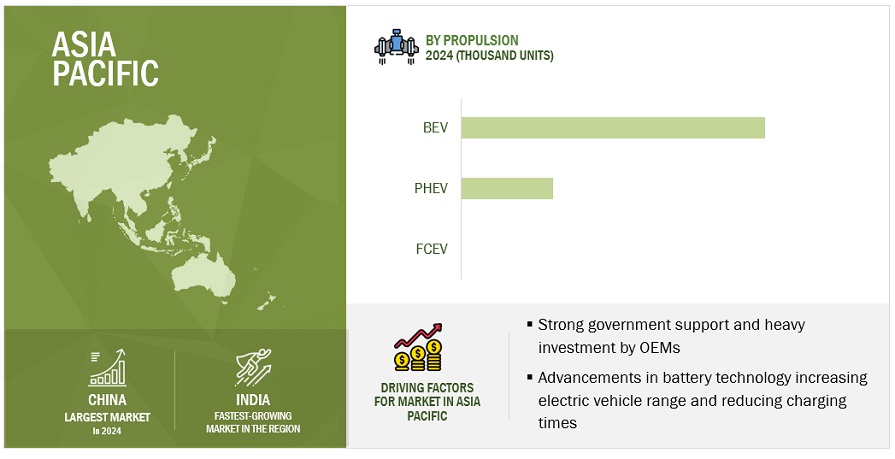
Key Market Players
The electric vehicle market is dominated by established players such as BYD (China), Tesla (US), Volkswagen AG (Germany), Geely-Volvo (China), and SAIC Motor (China). These companies manufacture and develop new technologies in the market. In May 2024, BYD launched the e-Platform 3.0 Evo, an upgraded version of its battery electric vehicle (BEV) model platform, as well as the first model based on the new platform, the Sea Lion 07 EV. During the same period, Volkswagen partnered with SAIC Motor for its premium brand Audi to develop a new China-specific platform for intelligent and electric vehicles. BYD has adopted strategies such as product developments and deals, whereas Volkswagen has expanded in new regions to gain traction in the market. In February 2024, BYD and the Emil Frey Group agreed on a partnership to distribute and sell BYD's range of innovative electric vehicles in Switzerland and Liechtenstein. In April 2024, Volkswagen announced plans to invest USD 210 million to upgrade and modernize its Kariega, South Africa plant to support the production of a new SUV-type model (starting in 2027).

Want to explore hidden markets that can drive new revenue in Electric Vehicle Market?
Scope of the Report

Want to explore hidden markets that can drive new revenue in Electric Vehicle Market?
This research report categorizes the Electric Vehicle market based on Component, Vehicle Type, Vehicle Class, Propulsion, Vehicle Drive Type, E/E Architecture, Top Speed, Charging Point Type, Vehicle Connectivity, End Use and Region.
Based on Components:
- Battery Cells and Packs
- Onboard Chargers
- Reducers
- Motors
- Power Control Units
- Battery Management Systems
- Fuel Cell Stacks
- Fuel Processors
- Power Conditioners
- Air Compressors
- Humidifiers
Based on Vehicle Type:
- Passenger Car
- Commercial Vehicle
Based on Vehicle Class:
- Low-priced EV
- Mid-priced EV
- Luxury EV
Based on Propulsion:
- BEV
- PHEV
- FCEV
Based on Vehicle Drive Type:
- Front Wheel Drive
- Rear Wheel Drive
- All Wheel Drive
Based on E/E Architecture:
- 400V
- 800V
Based on Top Speed:
- <125 Mph
- >125 Mph
Based on Charging Point Type:
- AC (Normal Charging)
- DC (Super Charging)
- Inductive Charging
Based on Vehicle Connectivity:
- V2B/V2I
- V2G
- V2V
Based on End Use:
- Private
- Commercial Fleets
Based on the region:
-
Asia Pacific
- China
- India
- Japan
- South Korea
- Thailand
- Indonesia
- Malaysia
- Vietnam
-
North America
- Canada
- US
-
Europe
- France
- Germany
- Spain
- Austria
- UK
- Netherlands
- Norway
- Denmark
- Sweden
- Switzerland
Recent Developments
- In June 2024, BYD launched its third electric vehicle, BYD SEAL, in Japan. The retail pricing for the rear-wheel-drive version of the vehicle in the country is 5.28 million yen (USD 33,111.75).
- In June 2024, Volkswagen announced an investment of up to USD 5 billion in the US electric vehicle maker Rivian as part of a new, equally controlled joint venture to share electric vehicle architecture and software.
- In April 2024, Tesla launched Model 3 Performance, a high-performance version of Tesla's popular electric sedan Model 3. It has 510 horsepower (up from 455), 296 miles of estimated driving range, an adaptive suspension system, a dedicated Track driving mode, upgraded brakes, sport seats, and a staggered wheel and tire setup.
- In February 2024, BYD and the Emil Frey Group agreed on a partnership to distribute and sell BYD's range of innovative electric vehicles in Switzerland and Liechtenstein. This partnership represents a significant milestone for both BYD and Emil Frey.
- In November 2023, Geely Mexico officially began operations in Mexico. The company presented two models, Geely Coolray 2024 and Geely Geometry C 2024, which are two new generation SUVs, one ICE and the other electric, respectively.
Frequently Asked Questions (FAQ):
What is the current size of the electric vehicle market by value?
The size of the electric vehicle market is estimated to be USD 396.4 billion in 2024 for electric passenger cars.
Who are the winners in the electric vehicle market?
The electric vehicle market is dominated by established players such as BYD (China), Tesla (US), Volkswagen AG (Germany), Geely-Volvo (China), and SAIC Motor (China). These companies manufacture and develop new technologies in the electric vehicle market. In May 2024, BYD launched the e-Platform 3.0 Evo, an upgraded version of its BEV model platform, as well as the first model based on the new platform, the Sea Lion 07 EV. In May 2024, Volkswagen partnered with SAIC Motors for its premium brand Audi to develop a new China-specific platform for intelligent and electric vehicles.
Which region is projected to be the fastest-growing market for electric vehicles?
Europe is projected to be the fastest-growing electric vehicle market region as strong government support is aimed at reducing emissions through policies, subsidies, and stringent regulations that support market growth over the forecast period.
What are the new market trends impacting the growth of the electric vehicle market?
The countries covered in the report for the electric vehicle market in the region are the US and Canada.
What countries have been covered in the electric vehicle market in the North American region?
The countries covered in the report for the electric vehicle market in the region are the US and Canada. .
To speak to our analyst for a discussion on the above findings, click Speak to Analyst
This research study involved the extensive use of secondary sources, such as company annual reports/presentations, industry association publications, automotive magazine articles, directories, technical handbooks, the World Economic Outlook, trade websites, technical articles, and databases, to identify and collect information on the Electric Vehicle market. In-depth interviews were conducted with various primary respondents, including key industry participants, subject-matter experts (SMEs), C-level executives of key market players (electric vehicle manufacturers and suppliers), and industry consultants, among other experts, to obtain and verify critical qualitative and quantitative information and assess market prospects.
Secondary Research
In the secondary research process, various secondary sources were used to identify and collect information on the electric vehicle market for this study. Secondary sources include annual reports, press releases, and investor presentations of companies; whitepapers, certified publications, and articles from recognized authors; directories; databases; and articles from recognized associations and government publishing sources.
Primary Research
Extensive primary research was conducted after understanding the electric vehicle market scenario through secondary research. Several primary interviews were conducted with market experts from both demand-side vehicle manufacturers [(in terms of component supply) country-level government associations and trade associations] and supply-side OEMs and component manufacturers across three major regions, namely, North America, Europe, and Asia Pacific. Approximately 30% and 70% of primary interviews were conducted from the demand and supply sides, respectively. Primary data was collected through questionnaires, emails, and telephonic interviews. In the canvassing of primaries, various departments within organizations, such as sales, operations, and administration, were covered to provide a holistic viewpoint in the report.
In the canvassing of primaries, various departments within organizations, such as sales, operations, and marketing, were covered to provide a holistic viewpoint in the report. After interacting with industry experts, brief sessions were conducted with highly experienced independent consultants to reinforce the findings from primaries. This, along with the opinions of in-house subject matter experts, led to the findings, as described in the remainder of this report.
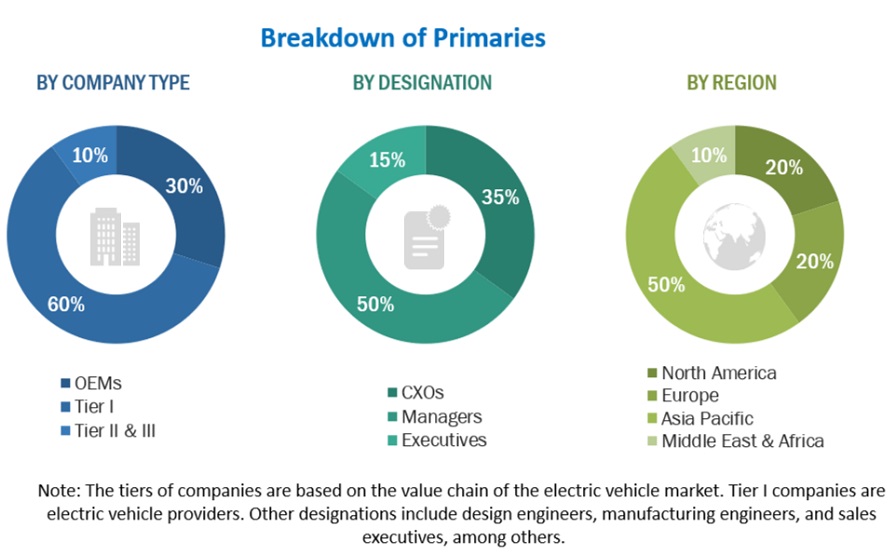
To know about the assumptions considered for the study, download the pdf brochure
Market Size Estimation
A detailed market estimation approach has been followed to estimate and validate the value of the global electric vehicle market and other dependent submarkets, as mentioned below:
- The market size has been derived by using parameters such as sales of electric vehicles.
- Segment split has been identified through primary and secondary research.
- Key players in the global electric vehicle market have been identified through secondary research, and their global market share was determined through primary and secondary research.
- The research methodology includes the study of the annual and quarterly financial reports & regulatory filings of major market players as well as interviews with industry experts for detailed market insights.
- All major penetration rates, percentage shares, splits, and breakdowns for the global electric vehicle market have been determined by using secondary sources and verified through primary sources.
- All key macro indicators affecting the revenue growth of the market segments and subsegments have been accounted for, viewed in extensive detail, verified through primary research, and analyzed to get the validated and verified quantitative & qualitative data.
- The gathered market data has been consolidated and added with detailed inputs, analyzed, and presented in this report.
The gathered market data was consolidated and added with detailed inputs, analyzed, and presented in this report.
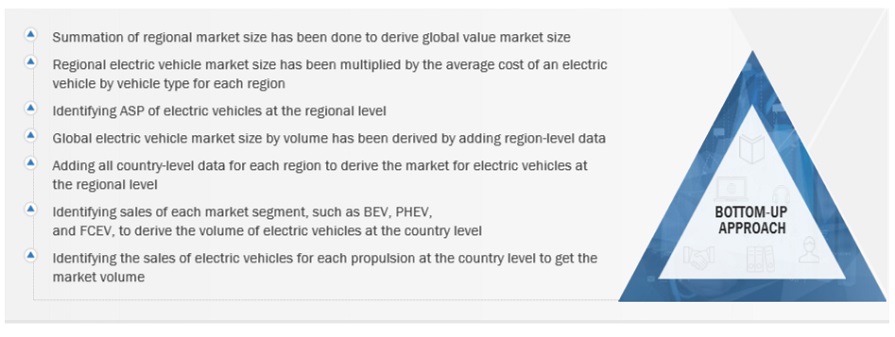
To know about the assumptions considered for the study, Request for Free Sample Report

Data Triangulation
All percentage shares, splits, and breakdowns were determined using secondary sources and verified by primary sources. All parameters that affect the markets covered in this research study were accounted for, viewed in extensive detail, and analyzed to obtain the final quantitative and qualitative data. This data was consolidated, enhanced with detailed inputs and analysis from MarketsandMarkets, and presented in the report. The following figure is an illustrative representation of the overall market size estimation process employed for this study.
Market Definition
An electric vehicle (EV) is an automobile propelled by one or more electric motors. An EV uses energy stored in rechargeable batteries, which can be charged using private or public charging infrastructure. There are four major types of EVs, namely, battery electric vehicles (BEVs), plug-in hybrid electric vehicles (PHEVs), hybrid electric vehicles (HEVs), and fuel cell electric vehicles (FCEVs)
List of Key Stakeholders
- Associations, Forums, and Alliances Related to EVs
- Automobile Manufacturers
- Battery Distributors
- Battery Manufacturers
- Charging Infrastructure Providers
- Charging Services Providers
- EV Charging Station Service Providers
- EV Component Manufacturers
- EV Distributors and Retailers
- EV Manufacturers
- Government Agencies and Policymakers
Report Objectives
- To segment and forecast the electric vehicle (EV) market in terms of volume (Thousand Units) and value (USD Million)
- To segment and forecast the market based on charging point type (AC (normal charging) and DC (super charging))
- To segment and forecast the market based on Propulsion [(Plug-in Hybrid Electric Vehicle (PHEV), Fuel Cell Electric Vehicle (FCEV), and Battery Electric Vehicle (BEV)]
- To segment and forecast the market based on vehicle type (passenger car and commercial vehicle)
- To segment and forecast the market based on vehicle class (low-priced, mid-priced, and luxury)
-
To segment and forecast the market based on vehicle top speed (<125 mph and
>125 mph) - To segment and forecast the market based on vehicle drive type (front-wheel drive (FWD), rear-wheel drive (RWD), and all-wheel drive (AWD)
- To segment and provide qualitative insights into the market based on vehicle connectivity (V2B or V2I, V2G, and V2V)
- To segment and forecast the market based on E/E Architecture (400V and 800V)
- To segment and forecast the market based on end use (private and commercial fleets)
- To provide qualitative insights on EV Components
- To segment the market and forecast its size, by volume, based on region (Asia Pacific, Europe, North America, and the Middle East & Africa)
- To analyze the technological developments impacting the market
- To analyze opportunities for stakeholders and the competitive landscape for market leaders
- To provide detailed information regarding the major factors influencing market growth (drivers, challenges, restraints, and opportunities)
- To strategically analyze markets with respect to individual growth trends, future prospects, and contribution to the total market
- To strategically profile key players and comprehensively analyze their market shares and core competencies
- To track and analyze competitive developments such as product developments, deals, and other activities carried out by key industry participants
AVAILABLE CUSTOMIZATIONS
With the given market data, MarketsandMarkets offers customizations in accordance with the company’s specific needs.
- Electric vehicle market, by vehicle drive type at country-level (for countries covered in the report)
- Profiling of additional market players (up to 5)




 Generating Response ...
Generating Response ...










Growth opportunities and latent adjacency in Electric Vehicle Market
We want to know the competitive scenario for Electric Vehicle Market? and the Top vendors in the EV Market for the Forecast period 2022 to 2030.
For the Asia market, we have provided the latest industry trends from both supply-side and demand-side, market insights for ASIA at the total and country-level (China, India, Japan and South Korea), and quantified the market size in units and revenues and growth forecast to 2030.
Electric Vehicle Market report also includes the latest industry trends from both supply-side and demand-side, market insights for ASIA market at the total and country-level (China, India, Japan and South Korea) data as well, and quantified the market size in units and revenues and growth forecast to 2030.